Style Compass.
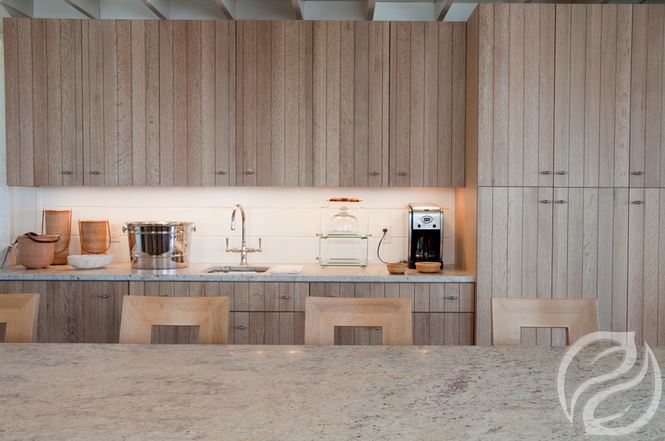
“It’s less fussy,” they say. “Maybe some of those ‘flat panel’ doors,” is heard. “I want it to look modern – not like our house in the burbs,” says another.
Consumers want it…they just aren’t quite sure how to explain it. That is “Transitional.”
Back in 2012, Transitional took the top spot for the style most often requested by consumers for the first time since the National Kitchen & Bath Association started tracking kitchen and bath trends in their Design Trends Survey.
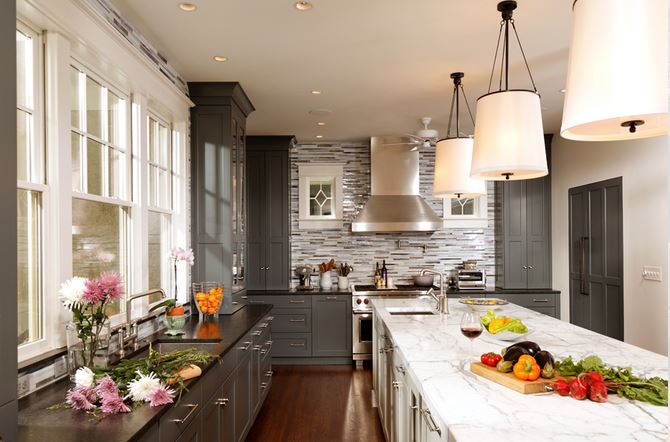 There are a couple of different reasons for that, but the main reason is when the economy is down, consumers want less fuss in their lives and this extends to the design of their new kitchens. When we are so consumed by events beyond our control outside the home, we want our lives inside to be simpler. The other reason is the baby boom generation has done the “fussy thing.” They’ve already lived through the styles of fuss and detail in design and they are, quite frankly, ready for a change.
There are a couple of different reasons for that, but the main reason is when the economy is down, consumers want less fuss in their lives and this extends to the design of their new kitchens. When we are so consumed by events beyond our control outside the home, we want our lives inside to be simpler. The other reason is the baby boom generation has done the “fussy thing.” They’ve already lived through the styles of fuss and detail in design and they are, quite frankly, ready for a change.
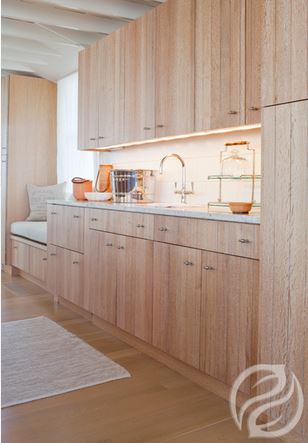
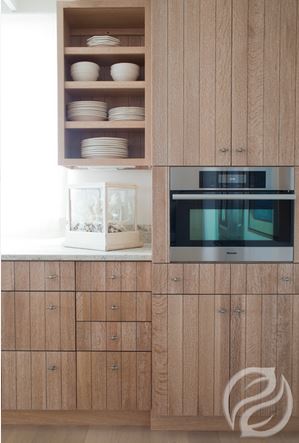 That has lead us to Contemporary. Contemporary is the fastest growing kitchen style in 2014, with 62 percent of designer respondents in the NKBA Design Trends Survey saying it’s on the upswing after ending 2013 in second place. (Transitional maintained a very small lead as the number one look for kitchens in the 2014 survey.) The difference between Transitional and Contemporary? Transitional mixes in some Traditional pieces and design lines and Contemporary is just plain cleaner lines.
That has lead us to Contemporary. Contemporary is the fastest growing kitchen style in 2014, with 62 percent of designer respondents in the NKBA Design Trends Survey saying it’s on the upswing after ending 2013 in second place. (Transitional maintained a very small lead as the number one look for kitchens in the 2014 survey.) The difference between Transitional and Contemporary? Transitional mixes in some Traditional pieces and design lines and Contemporary is just plain cleaner lines.
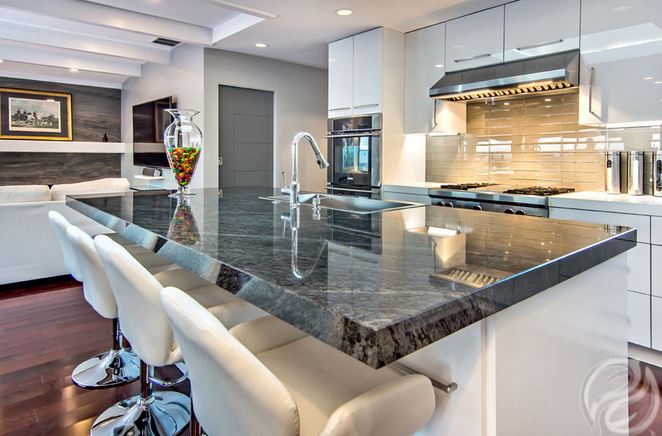 Contemporary is a bit “cold” for some of us though and that is why we are seeing what I think of as “Organic Contemporary.” It is the clean lines of Contemporary, with elements of nature and texture mixed in for warmth. A perfect example of Organic Contemporary – the cabinet company I prefer to work with, Greenfield Cabinetry, recently introduced a European Textured Oak door. It is a flat paneled, slab style door. Yet, it very textured both to the eye and to the touch and the wood adds the depth of warmth often missing from Contemporary styling. Other elements often found in Organic Contemporary are stone (often found in countertops), leather (think cabinetry pulls and now also found in some backsplashes or on floors, yes – floors!) and at times, you’ll find ceramics (often as a backsplash material). While other “proper” styles tend to be more about the lines, I think this style lends a nod to what we all desire in our lives – the warmth and security of home, as in this style we find and celebrate wabi-sabi. The best way to define wabi-sabi is found on nobleharbor.com:
Contemporary is a bit “cold” for some of us though and that is why we are seeing what I think of as “Organic Contemporary.” It is the clean lines of Contemporary, with elements of nature and texture mixed in for warmth. A perfect example of Organic Contemporary – the cabinet company I prefer to work with, Greenfield Cabinetry, recently introduced a European Textured Oak door. It is a flat paneled, slab style door. Yet, it very textured both to the eye and to the touch and the wood adds the depth of warmth often missing from Contemporary styling. Other elements often found in Organic Contemporary are stone (often found in countertops), leather (think cabinetry pulls and now also found in some backsplashes or on floors, yes – floors!) and at times, you’ll find ceramics (often as a backsplash material). While other “proper” styles tend to be more about the lines, I think this style lends a nod to what we all desire in our lives – the warmth and security of home, as in this style we find and celebrate wabi-sabi. The best way to define wabi-sabi is found on nobleharbor.com:
“Pared down to its barest essence, wabi-sabi is the Japanese art of finding beauty in imperfection and profundity in nature, of accepting the natural cycle of growth, decay and death. It’s simple, slow and uncluttered – and it reverses authenticity above all. Wabi-sabi is flea markets, not warehouse stores; aged wood, not Pergo; rice paper, not glass. It celebrates cracks and cervices and all the other marks of time, weather, and loving use leave behind. It reminds us that we are all but transient beings on this planet – that our bodies as well as the material world around us are in the process of returning to the dust from which we came. Through wabi-sabi, we learn to embrace liver spots, rust, and frayed edges, and the march of time they represent.”
The clean lines of Contemporary, mixed with the wabi-sabi of natural and time celebrated elements – is Organic Contemporary.
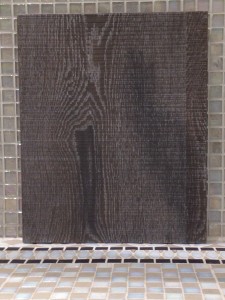
With all of that said – don’t write off Traditional just yet! While parents and grandparents are trending to Transitional and Contemporary, the 20-somethings with means are tending toward Traditionally styled kitchens! And from Euro-Cucina (the International design show held every other year in Milan, most recently in April 2014) we hear over the top Traditional, yes, you read that correctly – over the top Traditional made a strong showing for the first time in decades. Why? The emerging economies of the Asian and Russian markets are impacting design. They value Traditional styling and there is strength in these numbers and emerging economies, enough so that they are impacting style trends.
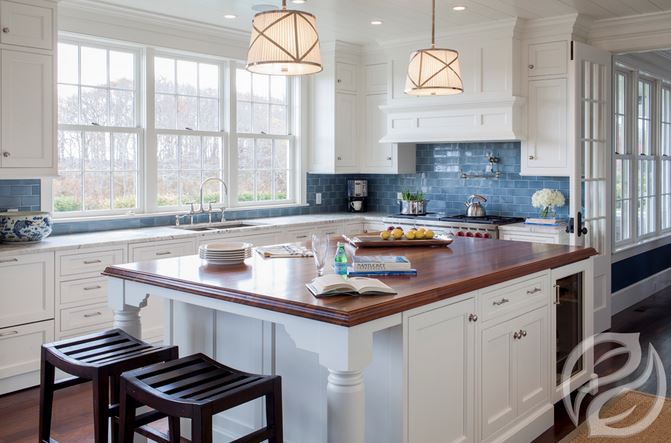 So what direction does the style compass point towards for our future? I am going out on a limb and am predicting that design cues will come from the emerging markets and 20 – somethings and we will see a Traditionally style future.
So what direction does the style compass point towards for our future? I am going out on a limb and am predicting that design cues will come from the emerging markets and 20 – somethings and we will see a Traditionally style future.
Who Knew About BLUE?
Heading into 2014, blue is one of THE most requested colors
Who knew about blue?
Heading into 2014, blue is one of THE most requested colors in kitchen cabinetry.
Why?
To fully answer that question, we need to back up to white. White has been the most popular color for quite a few years. (Just ask any kitchen designer, ANY one will tell you they’ve designed more than their fair share of white kitchens!)
White has always been a popular color in cabinetry, because it is safe. You can have white cabinetry, but change out the design components around it, from the countertops to the tchotchkes to the knobs & pulls; you can easily change the focal point, add a pop of color or update the overall look via your white canvas of cabinetry.
White is also a very safe color choice in a down economy .. and I’m pretty sure we’d all agree we’ve been through one of those recently! In a down economy, when we’re not sure if we are going to remodel, if we’re going to sell the house, if we’re upside down a bit on our mortgage.but, we can’t stand the way the kitchen functions or looks any longer, many of us have turned to white cabinetry because our color commitment is perceived to last longer.
Then, black became the new white. Oh, it was short lived, but I definitely noticed an up tick in black kitchens. Personally, I think these are the most beautiful, elegant kitchens ever designed. I can’t remember who the designer was, but he was out of the East Coast & he posted a black, traditional kitchen on his web site & it was by far, the most incredible kitchen I’d ever seen. It wasn’t that is was large or had some way out there focal point. It was a high-end kitchen, with common bells and whistles. And then, I was walking through Ikea in Denver in July 2012 and sure enough, 3 black kitchens were on display there. But, black has huge drawbacks when it comes to cabinetry. If you are a clean freak, forget black. Black cabinetry shows every speck of dust – it would drive you nuts. If you do any cooking at all in your kitchen, one touch of the cabinet with even a slightly olive oil laced fingerprint & cleaning would commence. I know from experience. I had a black island in a kitchen I remodeled in CO and it was very difficult to keep clean. Hence, the black trend was very short lived.
Then, we moved onto Grays. Yes, they are still hot & everyone wants grays. In my book, grays became hot because everyone had seen a white kitchen..or 2 or 3 or 4 or 5..and black was the natural next choice, but it turned out to be better for little black dresses than a kitchen full of cabinetry. So, the next natural color was between the 2, and gray became popular.
Gray grew in popularity as well, in thanks to the Restoration Hardware remodel of their brand, which brought in many grays and grays with texture. (Today, we all want texture, whether actual or perceived, but that’s an entirely different blog!)
Which brings me to blue. In cabinetry trends, we’ve gone from white to black to gray to.blue! And, it’s not just one shade of blues we are seeing. No sir! We are seeing everything from teals to light grayish-blues, to navy blues. Even the cabinet manufacturer I work with, Greenfield Cabinetry, reports an increase in requests coming into the factory for blue finished cabinetry. Blue is a very complimentary color, and it could be argued as well that it is a natural extension of gray. So, it stands to reason that blue was the next color we were destined to see in cabinetry. The popularity in this color is definitely not coming from the people who choose & foresee color trends, that’s for sure! Pantone’s last 2 color choices have been Tangerine & Emerald & Benjamin Moore’s 2014 color of the year is a purple.
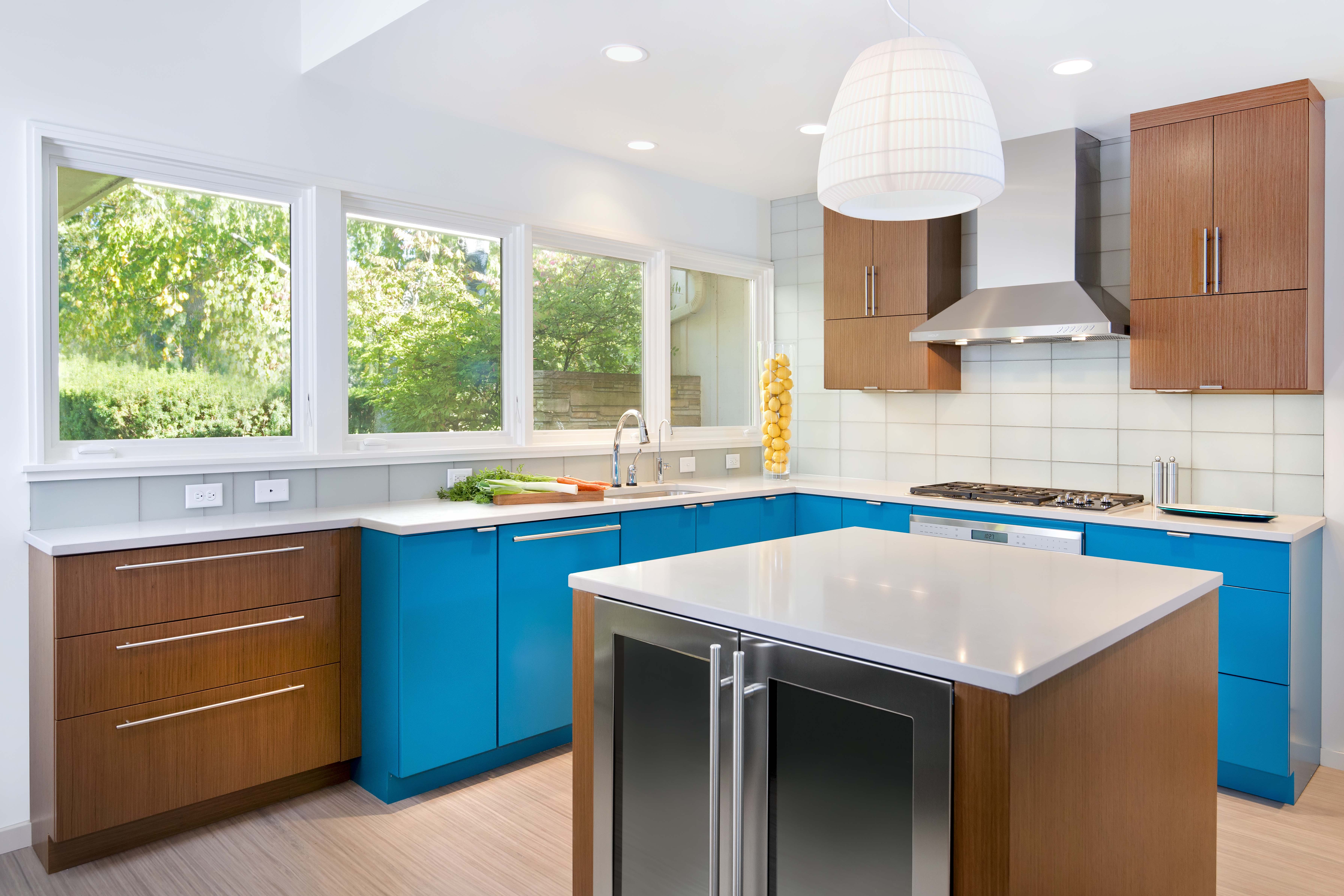
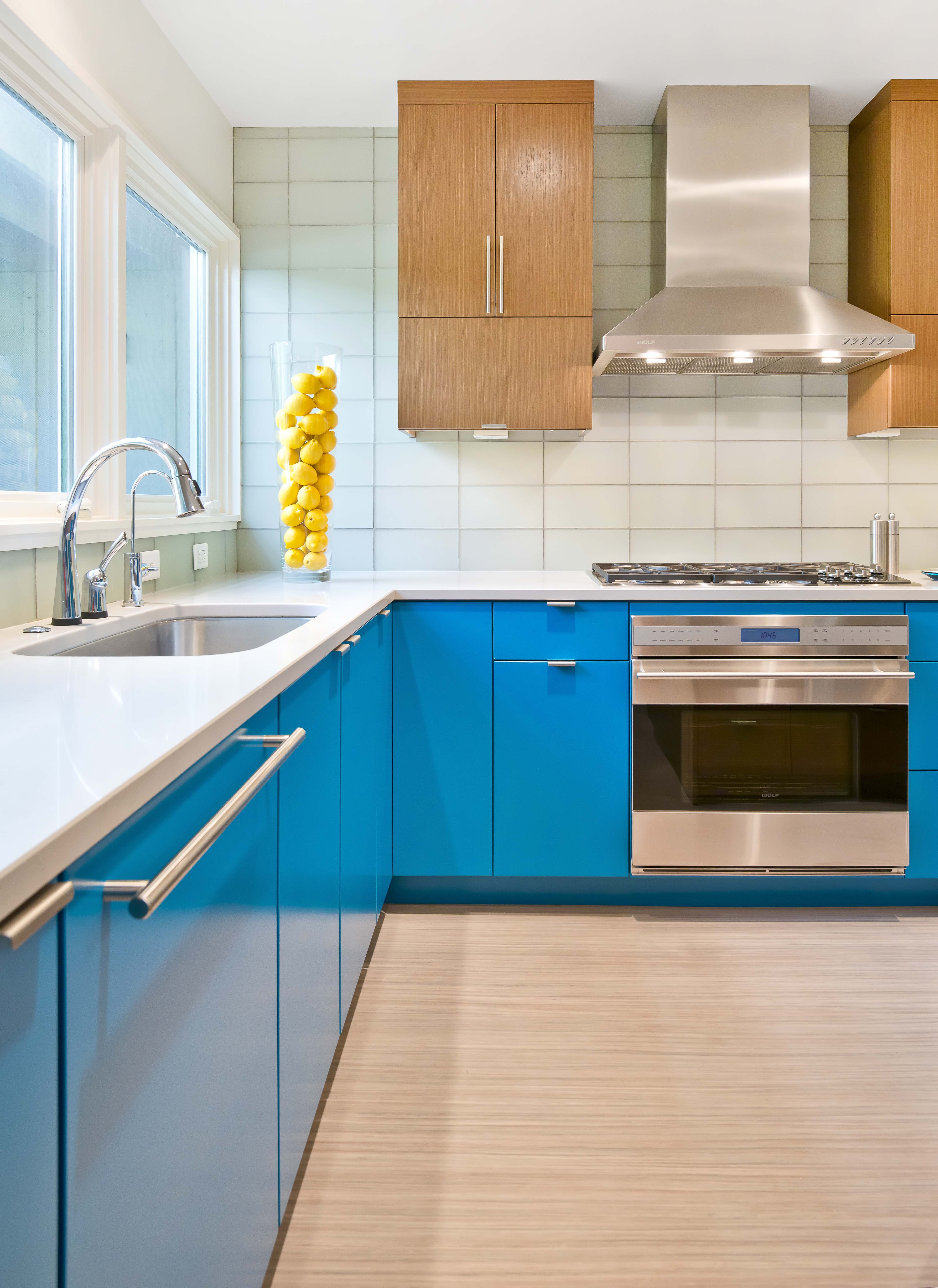
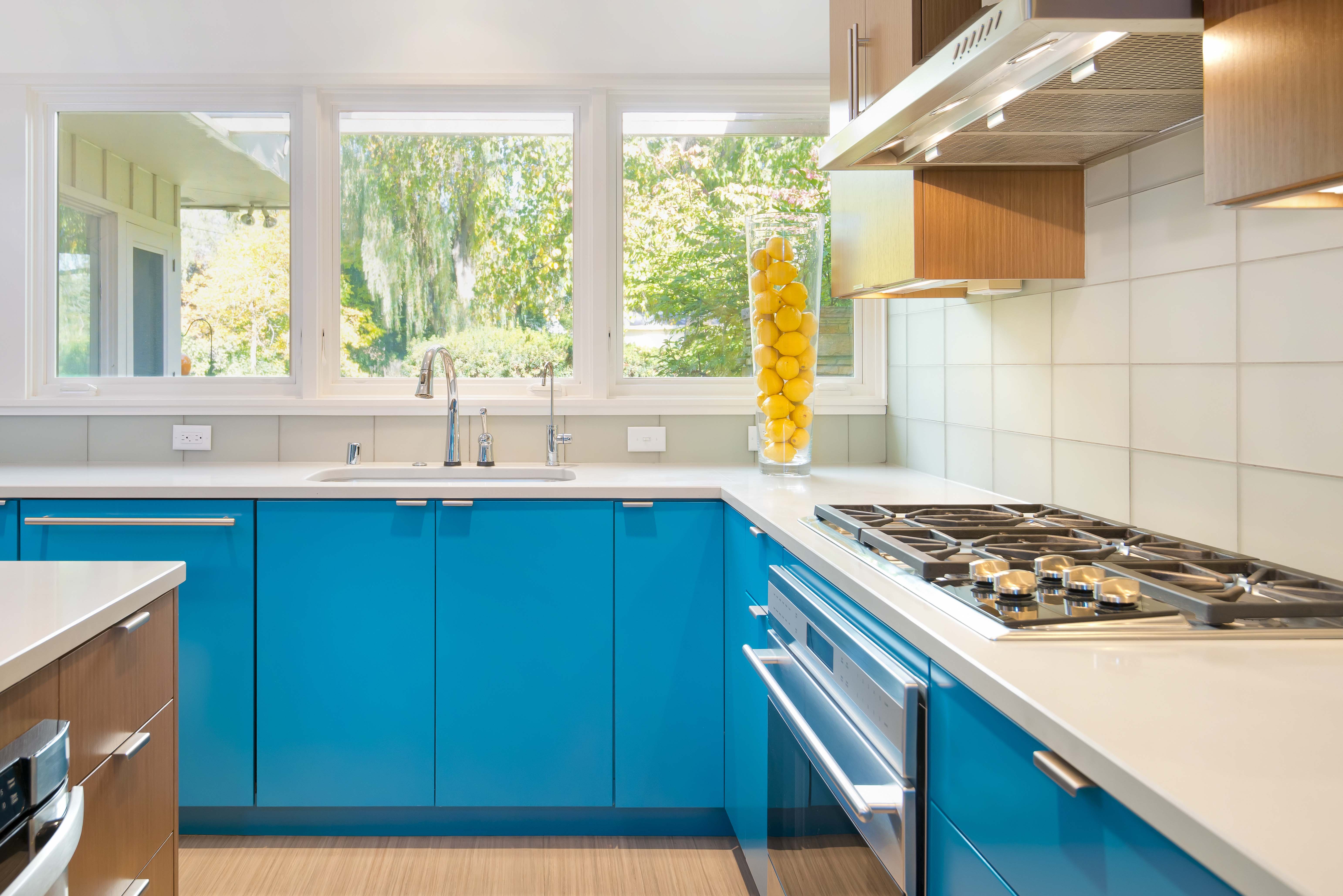
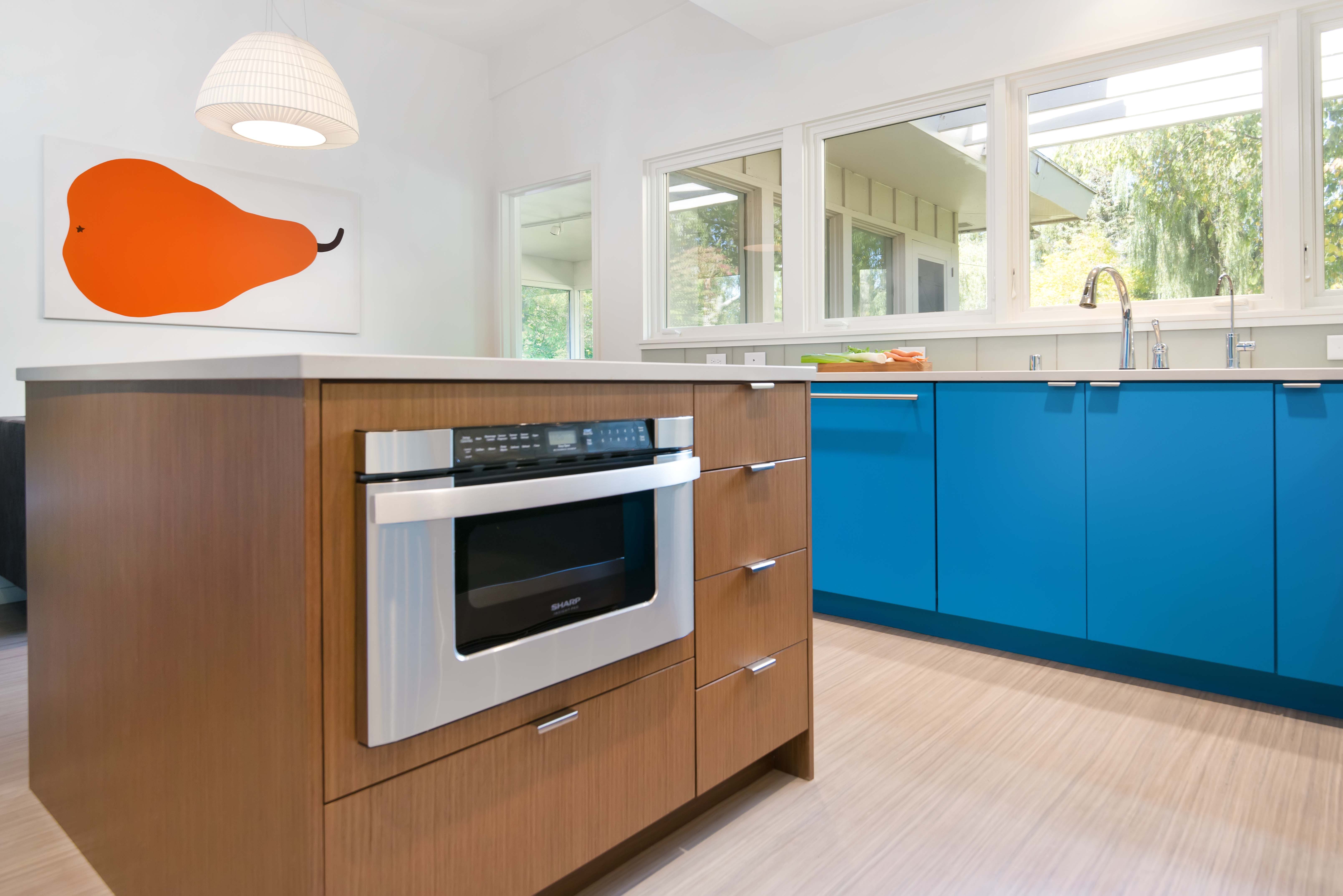 Yet, when it comes to blues, we need to take careful consideration. Blue does not reflect food well. Think about it – have you ever seen a fast food restaurant with a blue interior or a high end Chicago restaurant with a blue interior? My guess is no. That’s because colors such as red & orange inspire hunger & blue inhibits it. Blue just simply reflects food poorly. Food is not as appetizing when surrounded by the color blue. And, we begin eating with our eyes. Think about the number of times you’ve seen a photo, just a picture of your favorite food. Your mouth begins to water. From blue paint on the walls of your kitchen or your dining room to blue dinner plates, it is not the color you want to choose to surround food. It’s said that the exception to the rule is Mediterranean blue, because the Mediterranean countries are associated with food and the sea and many a fabulous terroir.
Yet, when it comes to blues, we need to take careful consideration. Blue does not reflect food well. Think about it – have you ever seen a fast food restaurant with a blue interior or a high end Chicago restaurant with a blue interior? My guess is no. That’s because colors such as red & orange inspire hunger & blue inhibits it. Blue just simply reflects food poorly. Food is not as appetizing when surrounded by the color blue. And, we begin eating with our eyes. Think about the number of times you’ve seen a photo, just a picture of your favorite food. Your mouth begins to water. From blue paint on the walls of your kitchen or your dining room to blue dinner plates, it is not the color you want to choose to surround food. It’s said that the exception to the rule is Mediterranean blue, because the Mediterranean countries are associated with food and the sea and many a fabulous terroir.
But, then again.rules are made to be broken. If you love blue, I say go for it. Personally, if I loved blue and just had to have it in my kitchen; I’d choose a different paint color, or most likely, a wood stain for the cabinetry on the perimeter of the room & then keep the blue below the countertop line and use it on the island.
And that is what I have to say on the 2014 trend topic of blue!
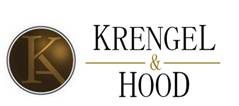

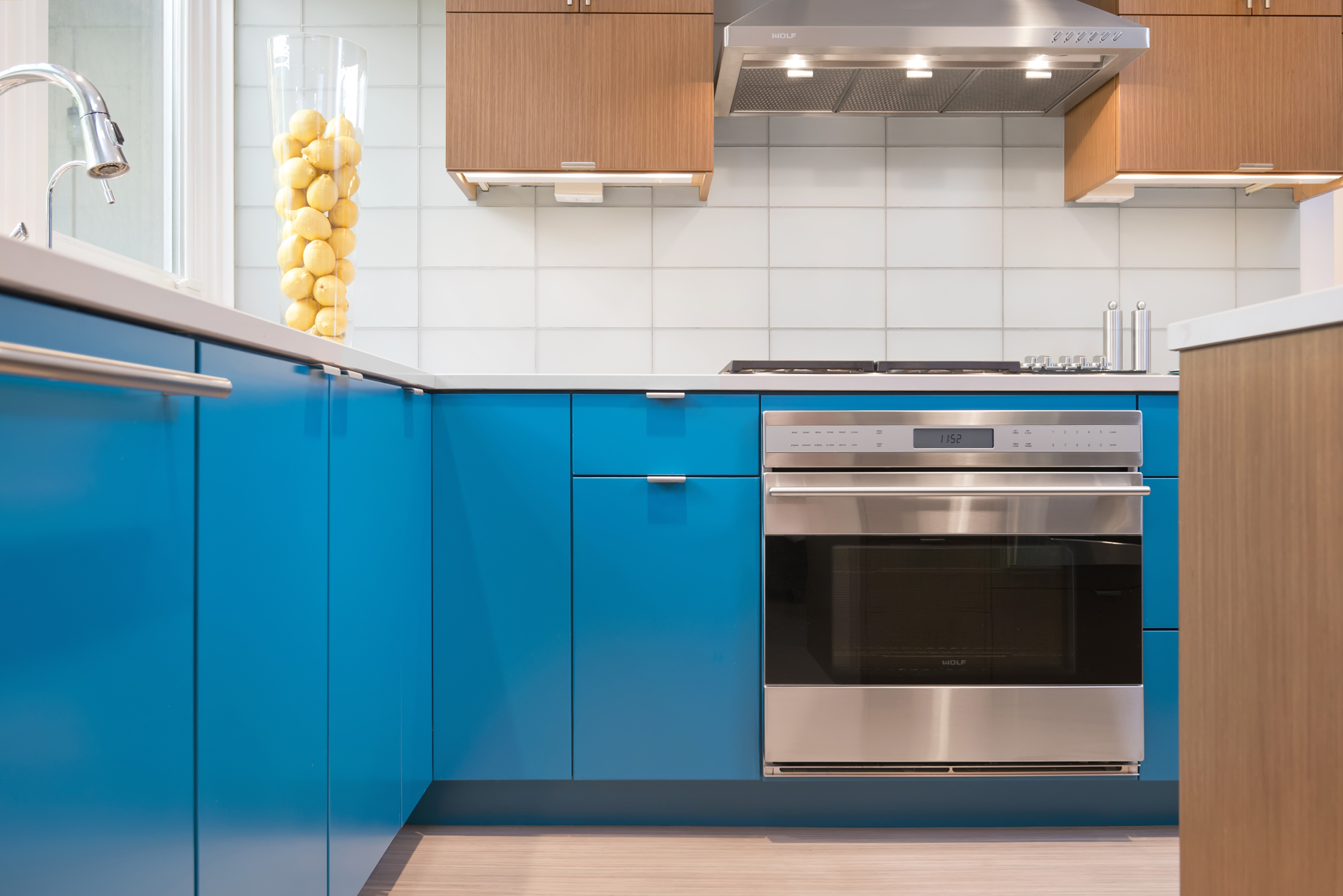
Recent Comments